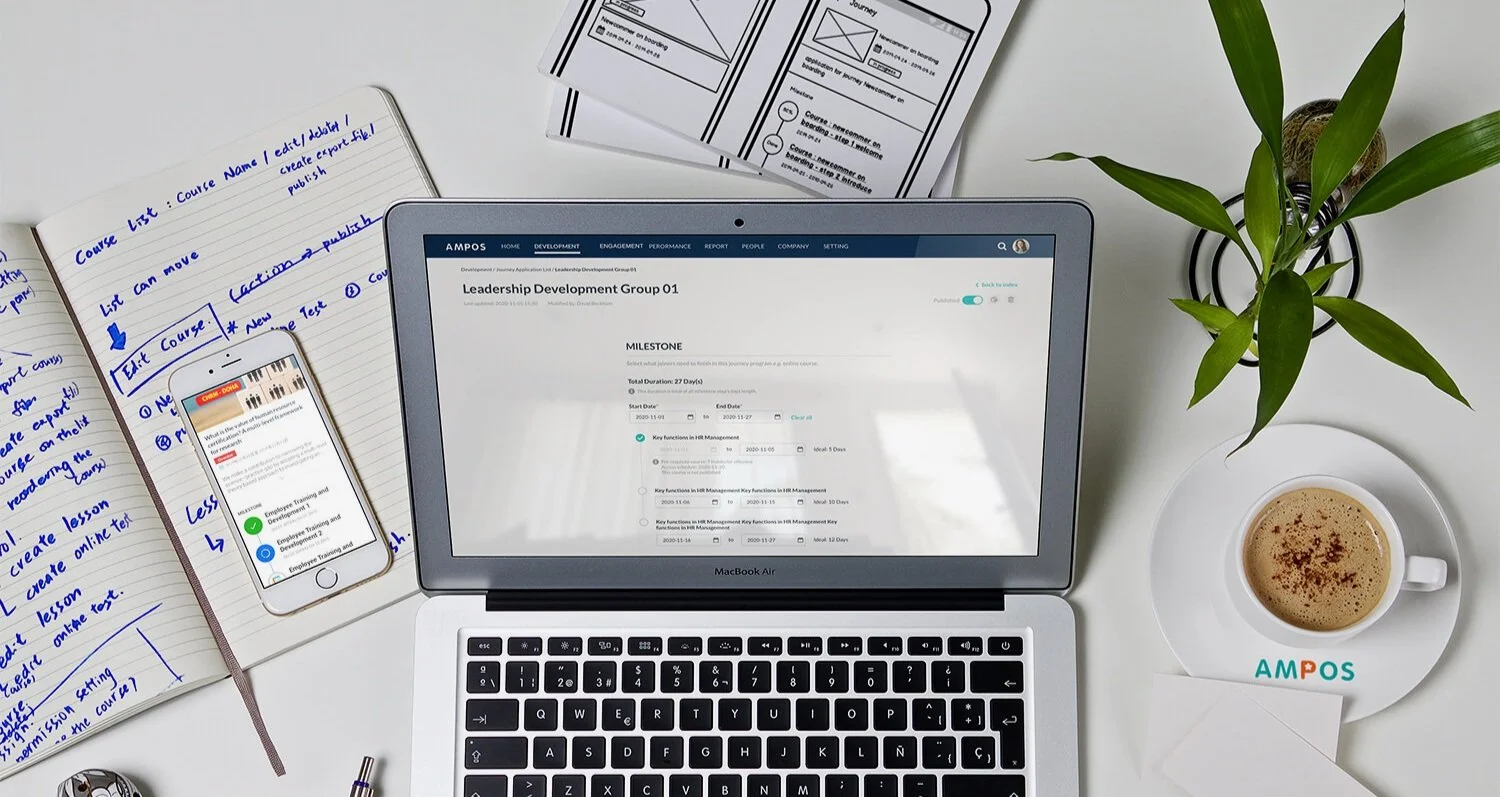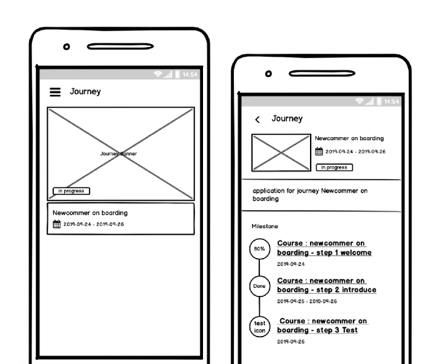Journey: The Exceptional Onboarding Product for HR Systems
An internal HR SaaS solution that links the functions of various products according to the user journey, creating a better onboarding experience.
Company
AMPOS
Platfrom
Web, iOS, Android
Date
2021
Challenge
Designing an onboarding process that effectively integrates new employees into the company culture and provides them with the necessary tools and information.
Outcome
A well-designed onboarding process that is enjoyable for new employees, leading to significantly increased employee engagement.
Role
Product Designer
Product Strategy, User Research, Interaction, Visual design, Prototyping & Testing, Information Architecture
Understanding the problem
The Report from CS Team
Selling new features to large enterprise clients with over 10,000 users is challenging because the cost of changing existing workflows is prohibitively high for these organizations.
For small and medium-sized enterprise clients, it is easy to compare each module with products on the market, which can lead to customer churn or fewer module purchases.
Admin users often ask us how to effectively use each module, while customer managers frequently need to assist clients in finding solutions for module combinations and applications. This can require a significant amount of manpower to address customer needs.
Our goal is to define the following objectives based on the identified issues and then validate them by confirming user needs through verification questions. We will then find solutions to these problems to achieve our product goals.
Objective
Improved relationships between modules and modules on product. Creating a smooth workflow provides effective solutions for customers.
Why Deserve to Do This?
For Product
By establishing relationships between modules and utilizing the functionalities of different modules to connect various workflows, we have the opportunity to reduce customer churn rate and increase module purchase rate.
For Admin User (HR, Manager)
Linking the functionalities of each module to create workflows tailored for each department, team, etc.
For Team
Create an environment where customers can easily and flexibly use each module to build their own workflows. This can effectively reduce the manpower costs of the Customer Success team.
For End User (Employee)
Creating smoother workflows for end users to improve their work performance.
Pain Point
Increasing module purchases among enterprise users effectively.
Effectively reducing churn rates for small and medium-sized enterprise users.
Empowering users to autonomously create workflows, thereby reducing the customer service team's manpower costs.
Initial Demand
Develop a new module enabling Admin users to connect functionalities of different modules, creating tailored workflows for departments and teams. This will enhance End Users' workflow experience, boosting purchase rates among large enterprises and reducing churn rates for small and medium-sized enterprises.
How Might We
How do we meet the varied needs of customers for different workflows?
By understanding the current workflows of both existing and potential customers, we can identify the most challenging aspects. This allows us to offer more effective solutions.
Focus Group
Through interviews with the CS team and customers, we learned about their needs and internal workflows, including onboarding, dispute resolution, departures, training, performance management, and talent pool management. New employee onboarding was highlighted as the most frequent and repetitive task.
How Might We
How do we automate high-repetition, labor-intensive, and inefficient workflows for Admin Users?
Based on the interview results, we will assess the value of automating the new employee onboarding process and break down its requirements to plan the MVP version.
Defining the problem statement
After gathering the findings from the research, I worked with the team to define the problem statement.
Onboarding Key to Retaining, Engaging Talent
According to the Society for Human Resource Management (SHRM), the cost of finding, hiring, and training a new employee is substantial. SHRM estimates that it takes a company 6 to 9 months of an employee's salary to find a suitable replacement. Training new employees should be a strategic process in an organization and should last at least a year to ensure high retention rates.
Additionally, BambooHR interviewed people who left within six months. Among those who left in the first six months, 23% said that clear guidance and clarity about their responsibilities would have helped them continue working. 21% said they wanted a more effective training method, 17% said a friendly smile or helpful colleague would have helped them stay, 12% said they wanted recognition for their unique contributions, and 9% said they wanted more attention from their manager and colleagues.
The product vision
As a product, we wanted to create an Exceptional Onboarding Journey for New Employees between modules and modules on product with 4 key focus areas
Journey Management (Admin)
Admin Users design different journeys for different people, like a database of travel plans. They use different module features to create unique onboarding plans for each employee.Journey Application (Admin)
Admin Users can assign any journey from the database to different employees and schedule the time needed for each journey. They assign onboarding plans to individuals or groups and set their start times. End Users get clear instructions on each task they need to complete.Journey Path (End User)
End Users start their journeys here. They receive their specific journey and begin at the scheduled time.Journey Report (Admin)
This is the monitoring center. Admin Users receive reports here about all journeys (completed, ongoing, and not yet started). They get real-time updates on End Users' progress, help them when needed, and track their progress and effectiveness.
Defining the MVP
During the 3-day intensive workshop, my team and I wireframed user processes and designed user stories to customize our strategic plan for launching the MVP. Here are the key features we collectively defined for the MVP:
Journey Management (Admin)
Journey List / Create New Journey / Create Milestone Step (Online Learning Module) / View Detail
* Considering technical constraints and development time, linking functionalities across multiple modules isn't straightforward. We prioritized the value of connecting modules and will develop them in stages, continually integrating them into the Journey.
Journey Application (Admin)
Auto Create Journey Application / View DetailJourney Path (End User)
Simple Journey PathJourney Report (Admin)
Due to technical and development time constraints, a comprehensive Report feature is not considered a priority for the Journey. Therefore, the Journey Report functionality will not be developed in the MVP version for now.
Designs
WIREFRAMING
For the wireframes based on the defined MVP features, it's crucial to consider not only the functionality of the MVP version but also whether user behavior aligns with the product and the flexibility in design for future possible developments. This will help collect feedback from developers and users effectively.
VALIDATING THE DESIGN
User usability testing with key users using a prototype to verify if the design can solve their problems.
FOLLOWING THE DESIGN GUIDELINE
To ensure design style and user experience consistency, it is essential to follow the design style guide established by the AMPOS design team throughout the design process.
Working with developers
The Scrum Team consists of one Product Owner (PO), five engineers based in Bangkok, and myself. We are collaborating to develop the MVP version within one month. We set different development goals for each Sprint and create corresponding tickets to ensure rapid progress and real-time understanding of each other's progress. The development steps are as follows:
STEP1: Confirm UX with wireframe and proceed to UI detailed design.
STEP2: Write Design Spec to confirm all details.
STEP3: Conduct a UI/UX Review to ensure consistency with the design before release.
STEP4: Include any new UI components in the Design Guideline.
Results and takeaways
Developing a new module is not easier than developing a new product. We need a clear understanding of the module's goals and its impact on the product. In the initial development phase, we prioritize fundamental issues over details to ensure resources are focused on the most valuable aspects. This approach allows us to step back from the UI/UX designer's viewpoint and make decisions that benefit the overall development. JOURNEY has also provided us with valuable feedback.
Successfully retained 85% of customers who were about to churn.
Extremely high user engagement.
Successfully increased module sales.













